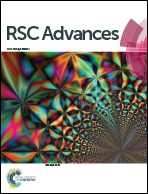Polymer precursor synthesis of TaC–SiC ultrahigh temperature ceramic nanocomposites
Abstract
TaC–SiC ultrahigh temperature ceramic nanocomposites were prepared by cross-linking and subsequent pyrolysis of a novel soluble blend precursor in argon atmosphere. The precursor was synthesized by blending polycarbosilane (PCS) with polytantaloxane (PT). The geometry of metal–ligand interaction of polymer PT was determined by the X-ray absorption fine structure (XAFS). The prepared ceramic nanomaterials were investigated with respect to their chemical and phase composition, by means of FT-IR, TG, X-ray diffraction (XRD), Micro-Raman spectroscopy, scanning electron microscopy (SEM) and high-resolution transmission electron microscopy (HR-TEM). Annealing experiments of the TaC–SiC samples at temperatures in the range of 1000–1800 °C showed conversion into nanostructured ultrahigh temperature ceramic composites with a trace amount of free carbon. The average grain sizes of the precursor-derived TaC and SiC ceramics were both less than 50 nm. Ta, Si and C elements were homogeneously distributed in the sample at the submicron scale.


 Please wait while we load your content...
Please wait while we load your content...